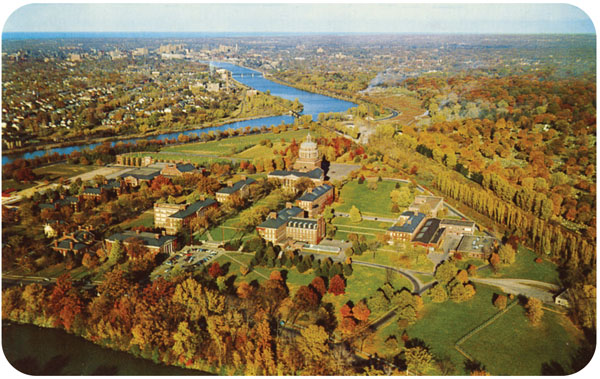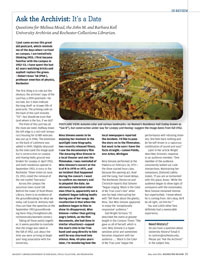In Review
 POSTCARD VIEW: Autumn color and various landmarks—no Women’s Residence Hall (today known as “Sue B”), but construction under way for Lovejoy and Hoeing—suggest the image dates from fall 1952. (Photo: University Libraries/Department of Rare Books, Special Collections, and Preservation)
POSTCARD VIEW: Autumn color and various landmarks—no Women’s Residence Hall (today known as “Sue B”), but construction under way for Lovejoy and Hoeing—suggest the image dates from fall 1952. (Photo: University Libraries/Department of Rare Books, Special Collections, and Preservation)I just came across this great old postcard, which reminds me of the days when I arrived on campus. I am tentatively thinking 1953. I first became familiar with the campus in 1952–53. I have spent the last 62 years watching bricks and asphalt replace the green. —Robert Knox ’58 (PhD ), professor emeritus of physics, Rochester
The first thing is to rule out the obvious: the archives’ copy of the card has a 1959 postmark—far too late, but it does indicate the long shelf- or drawer-life of postcards. The printing code on the back of the card includes “53”—but should we trust that (and where is the fun, if we do)?
The front of the card has all the clues we need. Halfway down the left edge is a red roof: temporary housing for GI Bill veterans was put up in 1946. The extension on the back of Lattimore was added in 1949. Slightly obscured by the trees (and the image quality) is construction on Lovejoy and Hoeing Halls; ground was broken for Lovejoy in April 1952, and both residences opened in September 1953. A story in the Rochester Times-Union on June 23, 1953, noted the removal of the red-roofed “barracks.”
Across the campus the autumnal trees stand tall. Behind the tower of Rush Rhees Library, there is no evidence of the groundbreaking for what we today call Susan B. Anthony Hall. (You can hear the speeches at the September 1953 groundbreaking here: http://livinghistory.lib.rochester.edu/womens-center.)
Taking all these points together, it seems possible to conclude that the image was taken in the fall of 1952, just about the time you were arriving to begin your long association with the University.
Nina Simone seems to be enjoying her moment in the spotlight (new biography, two recently released films). I saw the documentary film The Amazing Nina Simone in a local theater and met the filmmaker. I was reminded of Miss Simone’s concert at the U of R in 1970 or 1971, and an incident that happened during the concert. I want to confirm my memory and to pinpoint the date. An obviously inebriated older man (that is, apparently not a student) began talking loudly during one of her songs. My recollection is that when the audience began to hiss to show its disapproval, Miss Simone—rather than getting angry (which, as the film documents, she had done in similar situations)—cupped the man’s chin in her free hand and sang directly to him until he was charmed into silence. Now, 45-plus years later, I’m wondering how the local newspapers reported the incident. I’d like to pass the story on to the filmmaker, but want to be sure I have the facts straight.—LeAnn Fields, Ann Arbor, Michigan
Nina Simone performed at the Palestra on February 26, 1971—the show started hours late, because the opening act, Kool and the Gang, had travel delays. The Rochester Democrat and Chronicle reports that Simone “began singing ‘Black Is the Color of My True Love’s Hair’ when one fan kept interrupting her with ‘Tell them about the ghetto, Nina.’ But Miss Simone appeared to enjoy the ‘exceptionally responsive’ audience.”
Gail Wright Sirmans ’72 described the event at greater length in the Campus Times: “She gave us all of herself, which is rare. Miss Simone is a hypersensitive artist and sometimes becomes impatient with her audience . . . ‘Black Is the Color of My True Love’ began the performance with vibrating intensity. She held back nothing and let herself drown in a rapturous combination of sound and soul.”
Later in her article Wright describes Simone’s response to an audience member. “One member of the audience consistently lashed out rude interjections. Maintaining her composure, [Simone] calmly stated, ‘If you are so tormented with this place, leave.’ While the audience began to show signs of annoyance with the noisemaker, Nina Simone remained intense but unperturbed. ‘I know where he is coming from. He’s okay, he’ll be all right. Let him be.’”
You and 2,000 other fans definitely had a memorable experience.

